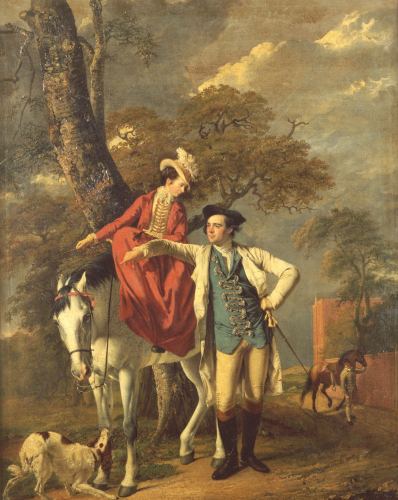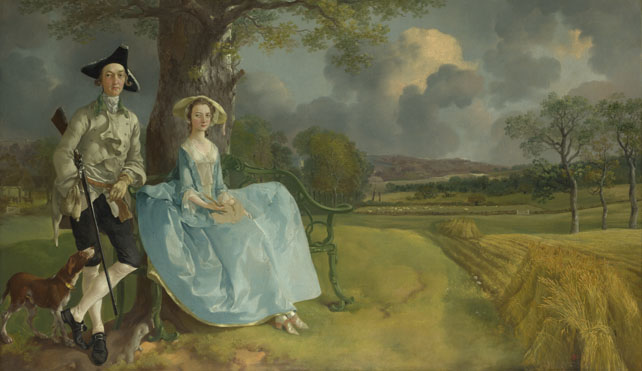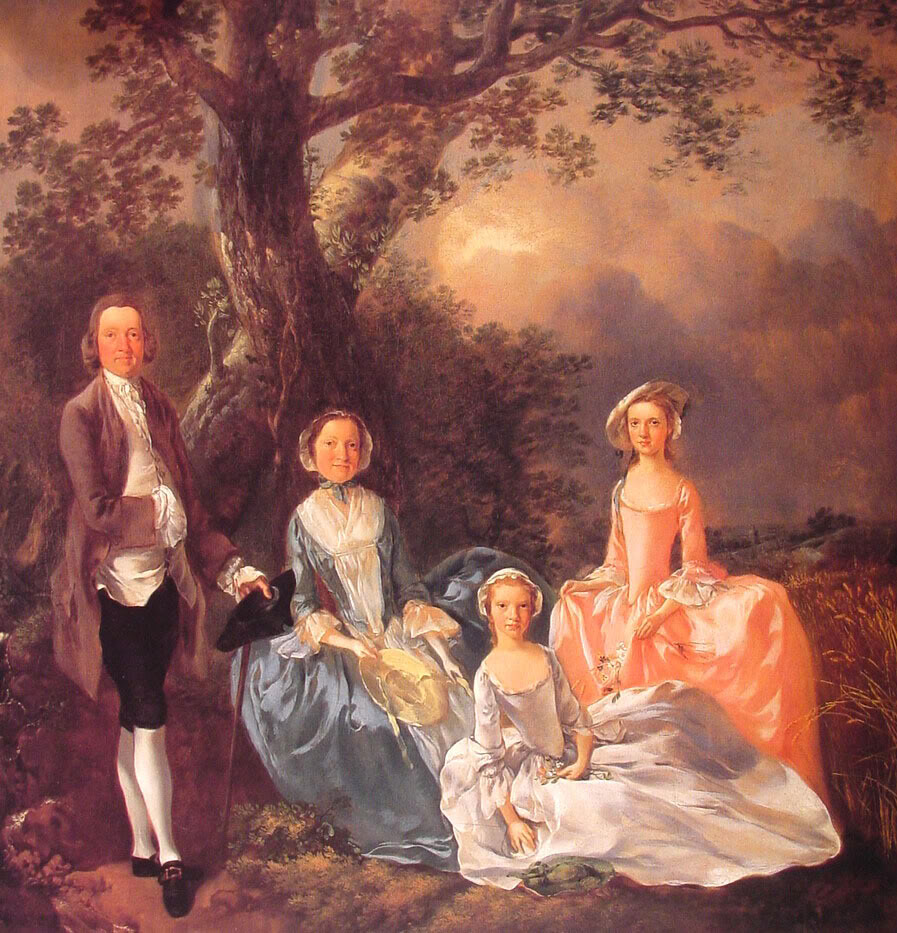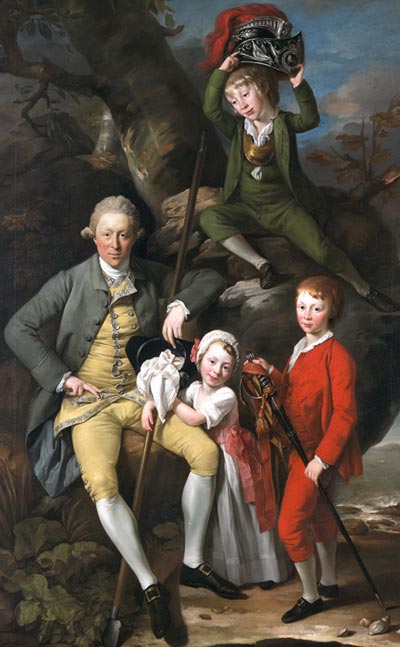And did those feet in ancient time
Walk upon England’s mountains green
And was the holy lamb of God
On England’s pleasant pastures seen
And did the countenance divine
Shine forth upon our clouded hills
And was Jerusalem builded here
Among those dark Satanic mills
Bring me my bow of burning gold
Bring me my arrows of desire
Bring me my spears o’clouds unfold
Bring me my chariot of fire
I will not cease from mental fight
Nor shall my sword sleep in my hand
‘Til we have built Jerusalem
In England’s green and pleasant land
‘Til we have built Jerusalem
In England’s green and pleasant land ( Words written by William Blake Music by Charles Hubert Hastings Parry)

With the correct eighteenth-century air of studied nonchalance, Thomas Coltman, of Lincolnshire, prepares to go riding with his wife. The portrait, by Joseph Wright, was done around 1772. At the time, wealthy gentlemen like Coltman, titled or not, had more scope for their talents and whims than perhaps any other privileged class in history.
They were the chlidren of time. The old English families. The lands upon which they lived had been theirs since the Middle Ages or earlier. Some, such as the Okehovers of Okehover, went straight back, son to father, beyond the Norman Conquest to Saxon times.
Their own memorials littered their landscapes, their churches and their houses; bits of castles, relics of ancient homes, oaks planted by ancestors almost lost in antiquity, recalled that the past was theirs; in church, effigies in marble or etched in brass gave them their long continuance; in their halls and dining rooms the portraits of their mosre recent dead enfolded them in the same sense of security in time. Here they had always lived and ruled, marrying into families like their own, so that across the English lands by 1750 there was a network of aristocrats as closely knit to their lands as the roots of their forests were.

Typical members of the British squirearchy, Mr. and Mrs. Robert Andrews appear under the lowering sky of their native Suffolk in a detail from an early work by Thomas Gainsborough that is now considered one of the artist's supreme masterpieces. Around 1748, when it was painted, landed gentry such as the Andrew's were able to lead a life of extraordinary privilege and freedom.
They did quarrel and fight with neighbors, sometimes pursuing their feuds over the centuries; some families rose, some fell, but most survived, like the great ancient oaks of their parks. Such antiquity, such social security, bred confidence, not necessarily confidence in oneself, for there were plenty of noblemen and gentlemen capable of self-doubt, but social confidence, not only in their present status but also in its continuing future.
What had so long endured was unlikely about to come to an abrupt end. Given reasonable luck and healthy sons, given reasonable prudence in the management of their estates, they could be sure that where they lived, so would their descendants for all forseeable time. Hence they could plan the future; remove hills, dig lakes, divert rivers and roads, plant forests, not for themselves but for their children and their children’s children. The thinking was that it didn’t matter if a new mansion might
rb the income of a lifetime , when so many more lifetimes could be counted on to follow.For the first time they had, as a class, money in abundance. Of course, there had been rich noblemen before the eighteenth-century who had poured money into the delights of life , who had lived in extravagant and costly ostentation. One has only to think of the Elizabethan aristocracy with its finery, its castles, and its parade of servants and retainers, But in Tudor days aristocrats were fewer, and their ostentation was an expression of pride, like a Potlatch among the Kwakiutl Indians, who burned their blankets and smashed their sacred coppers to show how magnificent it was to do so. Frequently, the Tudor aristocracy was desperately in debt.
But in the eighteenth century, due to the profits of improved agriculture, the expanding worldwide commerce of England, and the growing security of government finances, a large class of men, gentry as well as aristocrats, felt secure in their wealth as never before. And there was an even more subtle factor at work which was the beginning of what we could call consumer capitalism. It seemed good to spend; on trinkets, clothes, houses, gardens, sports and pastimes, food and drink, and all that delighted the eye, stirred the mind, or soothed the heart.

A new highly specialized form of painting came into fashion. This was the Conversation Piece, which portrayed groups of real people enjoying a pleasant moment within their own fine homes or outdoors on their own handsome estates , as in this gainsborough painting of the Gravenor family , done around 1748. the conversation piece provided a permanent testimonial to their success in the chief endeavor of the age: making life as sweet as possible
An thus, with increasing affluence and a growing pressure to spend, the nobility and gentry of eighteenth-century England created a style of life that was elegant, self-indulgent, worldly and immensely cultivated in the best sense of that abused word. Some of their pleasures were gross, many eccentric; but as a class their pleasures adorned their world and left posterity with a remarkable heritage.
Perhaps their best legacy was their greatest passion which was building and planting.Although they took pride in tracing their ancestors back to the Conquest or even, more arrogantly to the Romans, and boasted of their lineage in the heraldic embellishments that they engraved or painted or wove on all they possessed, they had little use for the taste of their ancestors. They ruthlessly demolished the rambling Tudor and Stuart manor houses or swallowed them up in the new Palladian palaces and villas that became the hallmark of aristocratic good taste.

Johann Zoffany, Henry Knight of Tythegston with his Three Children, 177o (It should be noted that Mr Knight was divorcing his wife at the time of the sitting)
Even before the Earl of Burlington, who in 1715 began to promote Palladio’s designs in England, the rage for building had taken hold. Sir John Vanbrugh had created several really enormous houses: the vast palace of Blenheim, a baroque monument fit for a sovereign prince; the gigantic Castle Howard with its extravagantly long facade; and Seaton Delaval in the wilds of Northumberland. Burlington and his painter-decorator henchman, William Kent, turned this growing appetite for building into a mania. Gentlemen became architects and architects became gentlemen. As with all fads, it had its moments of lunacy: One lady at court persuaded Kent to design her a dress with the five orders of columns.

Transportation becomes an amusement. A couple takes a ride in a phaeton, the light, open carriage much favored by the modish at the times george Stubbs did this painting, in 1787.
Enthusiasm combined with considerable architectural knowledge added greatly to the pleasures of life. The young nobleman on tour visited Vicenza, Padua, Venice, and then ordered his hired painter to sketch the villas so that the ancestral house in Yorkshire or Lancashire might be accordingly embellished. To contemporaries in England the first Neo-Renaissance houses were bewildering. The facade of Burlington’s house in Piccadily staggered Londoners; the Kentish folk had seen nothing like the huge dome at Mereworth Castle, which was a copy of Palladio’s rotunda outside Vicenza. Now however, these Palladian houses look as naturalto the English countryside as the Tudor manor houses that survive. These men were building villas not for themselves but for eternity. Private pleasure was enhanced by a sense of family duty. Within a mere thirty years, from 1710-1740, more than one hundred great country houses were either built or remodeled.








 COMMENTS
COMMENTS